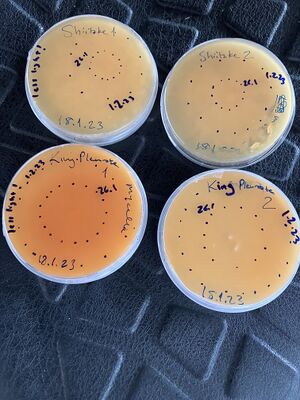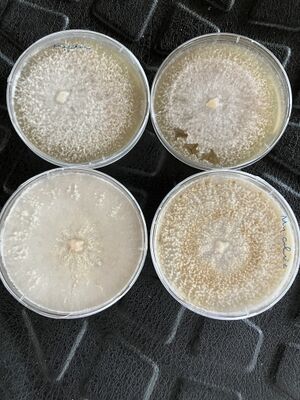Difference between revisions of "GrowthPatterns"
| (2 intermediate revisions by the same user not shown) | |||
| Line 1: | Line 1: | ||
The simple questions of how mycelia develop are not all fully understood. | The simple questions of how mycelia develop are not all fully understood. | ||
| + | |||
| + | This page is part of the [[Fun with fungi|Fun with Fungi]] project. | ||
| + | |||
| Line 5: | Line 8: | ||
This is our first experiment to try and find out why mycelia plates often have 'rings' ... | This is our first experiment to try and find out why mycelia plates often have 'rings' ... | ||
| − | Could it be due to something we do, when we look at them? | + | Could it be due to something we do, when we look at them? |
Our first hypothesis was that it could be exposure to light, which leads to the development of these rings. | Our first hypothesis was that it could be exposure to light, which leads to the development of these rings. | ||
| Line 23: | Line 26: | ||
From this test, it certainly looks like light is a key determinant, for formation of the obvious growth rings. | From this test, it certainly looks like light is a key determinant, for formation of the obvious growth rings. | ||
| − | The King Pleurotes even made some extra pigment, it seems from the light exposure! | + | The King Pleurotes even made some extra pigment, it seems, from the light exposure! |
| + | |||
| + | They are extra sensitive, too, as the 'shadow' plate shows a slight ring effect still (lower left), unlike the shiitake plate (top left). | ||
| + | |||
Hoping to get more people to try this, but the following pictures show our first result. | Hoping to get more people to try this, but the following pictures show our first result. | ||
Latest revision as of 09:53, 27 February 2023
The simple questions of how mycelia develop are not all fully understood.
This page is part of the Fun with Fungi project.
This is our first experiment to try and find out why mycelia plates often have 'rings' ...
Could it be due to something we do, when we look at them?
Our first hypothesis was that it could be exposure to light, which leads to the development of these rings.
In order to test this, we had duplicate plates made from two mycelia cultures, and one was kept mainly in the dark, while the other was exposed to light.
In the images to the right, can be seen the endpoint of our first tests: the top plates are Shiitake cultures, while below are from King Pleurotes.
Dotted lines show how far the mycelia edges grew on each date they were inspected.
The plates on the right side in these images were exposed to at least half an hour of light on the 'scoring' days...
The plates on the left side were mainly kept in the shade...
From this test, it certainly looks like light is a key determinant, for formation of the obvious growth rings.
The King Pleurotes even made some extra pigment, it seems, from the light exposure!
They are extra sensitive, too, as the 'shadow' plate shows a slight ring effect still (lower left), unlike the shiitake plate (top left).
Hoping to get more people to try this, but the following pictures show our first result.

